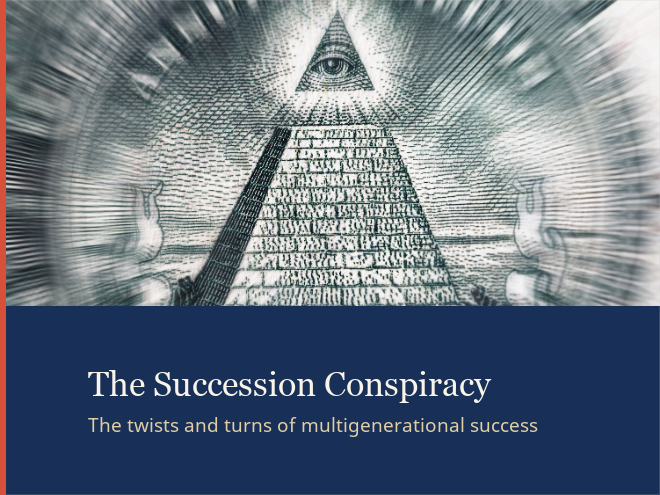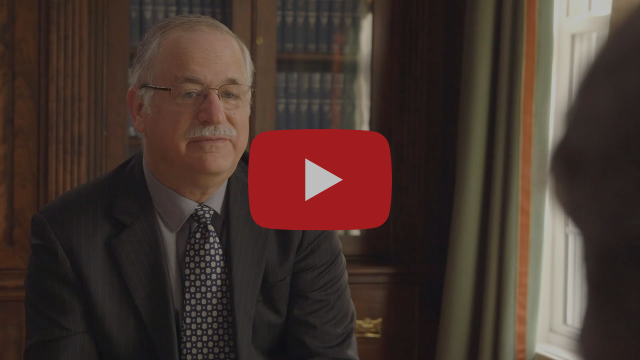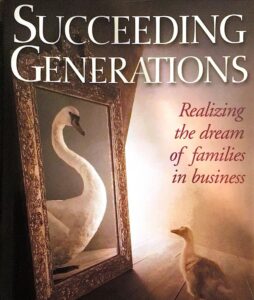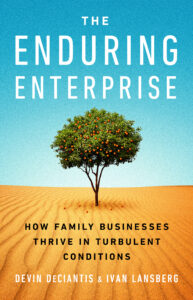Regardless of their success and size, many family enterprises struggle with succession process. Last year alone, we saw otherwise healthy telecom giants, fashion houses, and construction stalwarts deteriorate into conflict because they had neglected to address the sensitive question: what happens when a key leader dies or retires? If succession planning is such an obvious requirement for any family enterprise seeking continuity across generations, why do so many families fail to recognize or prioritize such a critical driver of long-term success?
In this classic article from the LGA archives, Ivan Lansberg examines the multiple forces that conspire to prevent succession planning in family firms — the Succession Conspiracy — and how enterprising families can get past these barriers to mobilize action and improve their odds at continuity.

By Ivan Lansberg, Ph.D. in Family Business Review
Max Weber, the great German sociologist, was among the first to identify the importance of having the leader of an organization turn over power to a successor who could solidify the administrative structures required for the continued development of the enterprise. In 1946, Weber referred to this process as the “institutionalization of charisma” and saw it as one of the greatest challenges of leadership.
These transitions of leadership impose a wide variety of significant changes on every family firm, family relationships need to be realigned, traditional patterns of influence are redistributed, and long-standing management and ownership structures and processes are forced to evolve. These changes are naturally anxiety provoking and create a need to resolve the uncertainties surrounding the future of the family enterprise. At the same time, resolving these uncertainties makes it necessary to address many emotionally-loaded issues that most leaders would prefer to avoid or deny.

In order to understand the resistance to succession planning, it is first necessary to understand the unique perspectives of the various stakeholders that make up a founder-led family enterprise. Each of these constituencies experiences ambivalent feelings about the inevitable succession transition. This ambivalence prevents key decision-makers from engaging constructively in planning for the exit of the leader.
A typical case study: Consider the leader who is repeatedly badgered by their oldest child about the absence of a succession plan. With every attack, the leader becomes increasingly defensive and moves to reassert their control over the family firm by procrastinating further. As the conflict escalates, this rising leader becomes increasingly unaware of some of their misgivings about the future (for instance, any doubts that they might have about their parent’s ability to perform competently in the top position or the fear of their parent’s death).
Likewise, the leader loses sight of their reservations about preserving the status quo (for example, a secret yearning to retire from day-to-day operational management). The result of the struggle is that the two cancel each other out. Unless each of the critical actors comes to terms with their ambivalence, it will be difficult to reach the level of cooperation needed for planning to take place.
Understanding ambivalence amongst stakeholders
The Leader. While leaders are often aware of many good reasons for developing a succession plan, they also experience strong psychological deterrents to managing their exit. One difficult deterrent to succession planning is the leader’s reluctance to face their own mortality.
Founders also resist succession planning because it entails letting go of their power to influence the day-to-day running of the business. In many cases, leaders became entrepreneurs precisely because of a strongly felt need to acquire and exercise power over others. Surrendering power over the firm is thus experienced as the first step toward losing control over life itself.
In addition to the loss of power, leaders also resist succession planning out of fear of losing an important part of their identity. For an entrepreneur, their organization defines their place in the community and in the world at large.
The stereotypes that we carry are of legendary leaders who have “died in the saddle” or “gone down with the ship,” not of leaders who have thoughtfully planned their exit.
The Family. In order to understand the family’s reaction to succession planning and the reasons why its members might want to avoid the planning process, it is important to consider their stage in the life cycle at the time of succession. The need to start thinking about succession planning does not typically arise until leaders enter the final chapter of their professional career (around age sixty). By this time, the last of their children have often left home, and the couple may be struggling to adjust to the vacuum produced by the empty nest. Unresolved marital difficulties that for years had lain dormant, masked by the continuous pressures of child rearing and business startup, reemerge during this period.
Couples at this stage sometimes resort to emotional strategies such as denying the need to deal with succession, refusing to relinquish power, and reasserting their authority and centrality in both the family and the business hierarchies.
In addition, the children are eager to establish their own financial independence and autonomy at this stage of their lives. These conditions make it unlikely that the offspring will be patient and supportive of the parents’ attempts to assert their power over family members. On the contrary, the offspring may resort to displacing their own difficulties with succession onto the leader, who is viewed as the only obstacle to their own advancement within the family enterprise.

The Managers. The difficulties with succession are not limited to the leader and the family. The firm’s managers are also confronted with difficult emotional issues that lead them to resist planning. Many senior managers are reluctant to shift from a personal relationship with the leader to a more formal relationship with a successor.
In most cases, these managers have developed unique ties with the leader that extend well beyond the parameters of a contractual work arrangement. For many senior managers, personal ties with the owner constitute the single most important advantage of having worked for a family firm over the years.
The Owners. Whether they are family members or not, difficulties in succession planning typically stem from the way in which owners acquire their share of ownership.
Often, the leader has passed along some share of their ownership to these individuals as a gesture of goodwill or in recognition of some special contribution that these people either have made or are expected to make. Gift or sale carries with it an implicit expectation of loyalty and allegiance to the leader that makes it very difficult for internal minority owners to raise questions about succession planning without appearing to be disloyal.

The Environment. Resistance to the succession planning process is not limited to the individuals who are directly involved with the family firm system. Environmental forces also create barriers to succession planning. These forces consist of the client’s suppliers who have grown dependent on the leader as their primary business contact in the firm. These people know that the leader is the person to whom they must speak when they want action. Although it is clearly in the client’s long-term interest that the firm plan for its healthy continuation, clients and suppliers worry about losing their connection to the top and frequently side with the leader in avoiding the effort to plan succession.
It is worth noting here that our cultural values do not generally support leaders who plan their succession. The stereotypes that we carry are of legendary leaders who have “died in the saddle” or “gone down with the ship,” not of leaders who have thoughtfully planned their exit. Since leaders view themselves as centrally responsible for the well-being of their families and their firms, they do not take such cultural messages lightly.
The resistance to succession planning is difficult to change, and it is very unlikely that a first-generation family firm can mobilized itself for succession planning unless the leader is willing.
Strategies for effective succession planning
Effective succession planning therefore requires a systemic approach which addresses resistance of the leader, the family, the senior managers, and the owners.
How to mobilize the leader
Help the leader develop a supportive network of peers who can empathize and share learnings.
Be attentive to timing, paying particular attention to how the leader is coping with their fears of death.
Heighten the sensitivity of the family to the needs of the leader.
Provide the leader with specific data about the steps involved in the development of a succession plan, and, if possible, get them to develop a timetable.
Help the leader to design a role for the future that will motivate them to let go of their present involvement in operational management.

How to mobilize the family
Help the leader and their spouse to develop a shared vision of the future. Help the leader and their spouse to seek marital counseling if needed.
Develop a family council that facilitates meetings of family in which members discuss their values and expectations for the business and for one another.
How to mobilize the managers
Create a succession task force and build in incentives that reward serious involvement in the development of a succession plan
Encourage planning for succession for senior managers as well as for the leader.
How to mobilize the owners
Create a board of directors that is appropriately staffed and that provides an independent perspective that can safeguard the interests of the owners.
What all families can do to get started
The resistance to succession planning is difficult to change, and it is very unlikely that a family enterprise can mobilize itself for succession planning unless the leader is willing. In a very real sense, the leader retains his power to perpetuate or destroy their life’s work right up to the very end.
Nonetheless, families can deploy a systemic approach that includes the development or utilization of structures such as a Family Council, a Board of Directors, and a Succession Task Force, involving all key stakeholders whose cooperation is critical for the development and implementation of the family’s overall continuity plan.
Thanks for joining the global community of families who use these insights to support their continuity. We look forward to sharing more with you in the next LGA Quarterly!
Sincerely,
Your LGA Team








